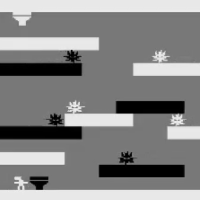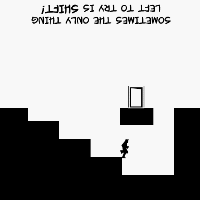
by: Richard Terrell @KirbyKid
March 3, 2014
Every mission in Starseed Pilgrim starts off on a cube floating in the middle of empty white space. It doesn't take long to realize that the real experience, the goals of each level are off screen and out of view, floating somewhere in the white abyss. Players must construct platformable paths from their starting location outwards in search of keys and three-key doors. Though the game doesn't explicitly state it, the goal of Starseed Pilgrim is to enter the fleeting world, amass seeds, explore to find at least one key, return via the single-key door in the flip worlds, explore the overworld to find every pilgrim explorer, and eventually conquer each pilgrim's three-key challenge to collect the ten golden seeds. For any fleeting world level, the essential player objectives include farming seeds, exploring the area, and either returning to the overworld via the single-key door or exploring the fleeting world further to find three-key-doors; these objectives will be the focus of the remainder of the level design analysis.











Enter fleeting world
Amass starseeds
Explore to find a key
Connect to the star block. Collect key.
Return to the single key door.
Or find 3 stars and the triple star block.
Collect 3 keys.
Enter the triple key door.
Collect the heart for a golden seed!
|<<
>>|
1 - 9
<
>
Starseed Pilgrim's gameplay can be thought of as two genres in one. The first is the puzzle genre: Where the core gameplay revolves around taking these spatial pieces (seeds) and fitting them together, thus stressing player knowledge of the starseeds. The second is the platformer genre: Where the player controls a character in 2D side-scrolling space featuring gravity, which makes navigating vertically distinct and more engaging than navigating horizontally. With platforming, players must not only gauge JUMP distances, but also be mindful of the timing of nearby hazards and obstacles. Out of the five core types of skill (DKART: dexterity, knowledge, adaptation, reflex, and timing) puzzle games stress knowledge most of all, while platformers tend to stress timing and reflex. So when analyzing the gameplay and level design of Starseed Pilgrim, we should consider how the level limitations and mechanics shape the puzzle and platforming challenges, including how these challenges blend together.





In Starseed Pilgrim, seeds grow platforms. Through normal play, players will tend to create a variety of platformable structures due to the diverse design space of the seeds and the randomized seed queue. With the ultimate goal of collecting keys and entering three-key doors, the sub-objectives of farming seeds from pink blocks and moving outward efficiently to explore the white abyss are prioritized. While the wrinkles in the seed design space are a major factor in creating interesting choices in the puzzle-like, seed-placement gameplay, the platforming gameplay never blooms beyond basic JUMPS. Tricky JUMPS are rare and there's little need to adjust movement in mid-air. There's no triple jump (e.g. New Super Mario Bros.) or wall jump (e.g. N+, Super Meat Boy) mechanics that would allow players to interact with vertical obstacles in distinct ways. There's no horizontal momentum to make precise JUMPS more complex, challenging, and engaging. Starseed Pilgrim also doesn't have anything that functions like the basic Goomba enemy from Super Mario Bros., which challenges players to avoid a dangerous moving obstacle or precisely land on top of it.
I argue that Starseed Pilgrim is much more of a puzzle game than a platformer. This is not to say that controlling the pilgrim is trivial. Having to move to specific locations to PLANT seeds underfoot and being forced to move back and forth across the non-corrupted platforms is an elegant way of limiting how players use seeds. Between traveling back and forth, managing the timing of off-screen events, and getting to the right spots in time, the limitations of controlling the pilgrim make Starseed Pilgrim more challenging in an organic way. My point is you'll be thinking about when and where you want to be more so than challenged on how to get there. When exploring in Starseed Pilgrim, there's about as much platforming action as Pushmo, a puzzle game. Like Wario's Woods or even the indie game Tuper Tario Tros. (a hybrid game that fuses Tetris and Super Mario Bros.), puzzle platformers often focus on puzzle gameplay over platforming gameplay, or they compartmentalize the two styles.
I should say that I still greatly appreciate the light platforming gameplay in Starseed Pilgrim. I will always enjoy jumping on blocks and transforming the terrain in a Mario-like way. Perhaps the most notable platforming gameplay occurs in the flip world. By touching the void with most pilgrims, in an instant, every platform becomes open space and every open space becomes a solid black wall. This shift between positive and negative space reminds me of the indie games Shift and Jumpman. While the platforming during the exploration phase is quite straightforward, inside the negative world there are a few new elements to consider. Grabbing a key and traveling back to the starting area creates something like folded level design; a type of level design where players are challenged to move through a space, and then challenged in a new way as they travel back through it. For a simple example, you may JUMP down into a pit to grab a key, but it can be too tall for you to JUMP back out. Navigating to the key is easy, but returning with the key is tricky. Naturally, using gravity is an effective way to create these kinds of folded platforming gameplay challenges.
Additionally, the floating hearts in the negative world function like coins from Super Mario Bros. If your goal is to gather three keys and enter the three-key door, then you'll likely have to spend more time navigating inside the flip world. While the fleeting world features an organic time pressure, the flip world has a time pressure as well. If you linger too long, the flip world will fade to white and you'll be kicked out to the overworld, losing all seeds and keys. Basically, it's game over. The only way to extend your time in the flip world is to grab floating hearts that were previously embedded randomly inside of green seed blocks. These Mario-coin-like pickups are enough to make the platforming challenges in the flip world somewhat interesting. Add in the BUBBLE mechanic, which allows players to spend a seed to float around in the flip world, and the platforming gameplay between the fleeting world and the flip world become very distinct. It's surprising how effective coin-like design features can be when coupled with a costly anti-gravity mechanic (BUBBLE). With my skills and a few tricks I discovered, I found that my platforming skills in the flip world allowed me to be even more conservative with my seed count.
Everything discussed so far with Starseed Pilgrim's level design has been about the direct result of actions initiated by the player. It's hard to consider the seed platforms and flip world as cases of level design when the player is the one creating the structures. Ultimately, in the fleeting world, exploring the white abyss, there is no clear direction or level design. Only the hope of finding a key somewhere just off screen that drives players. And while the randomly arranged star blocks do a good job of focusing player strategies around using seeds to maneuver to or around these floating goals, their arrangement isn't consistent enough to analyze level-design-wise. That only leaves us to consider the three-key room challenges.
The three-key rooms are what Starseed Pilgrim offers that is closest to designed levels. The stage layouts for the three-key rooms are the same every time, and each room challenges players to navigate to the floating heart using the seeds left over from progressing through the fleeting and flip worlds. Outside of these rooms, the level design in Starseed Pilgrim is very open, variable, and unable to focus the gameplay in specific ways like Tetris or Boxlife. The three-key rooms are the opposite. Instead of the same starting block and white abyss dotted with randomly arranged keys to find, each three-key room is specifically designed around the nuances of the seed and pilgrim design. For example, for the purple pilgrim who can't DIG, its three-key room is one where there are two main paths to the goal. (see image 17 and 18 above) One path goes down and to the right. The other goes upwards. Though requiring a bit of luck, the low path is far more efficient to take. Because you can't DIG, though, you have to be careful which seeds to use, or you can easily fail. I wish more of Starseed Pilgrim was designed like these three-key rooms.

























1 - 21
<
>












